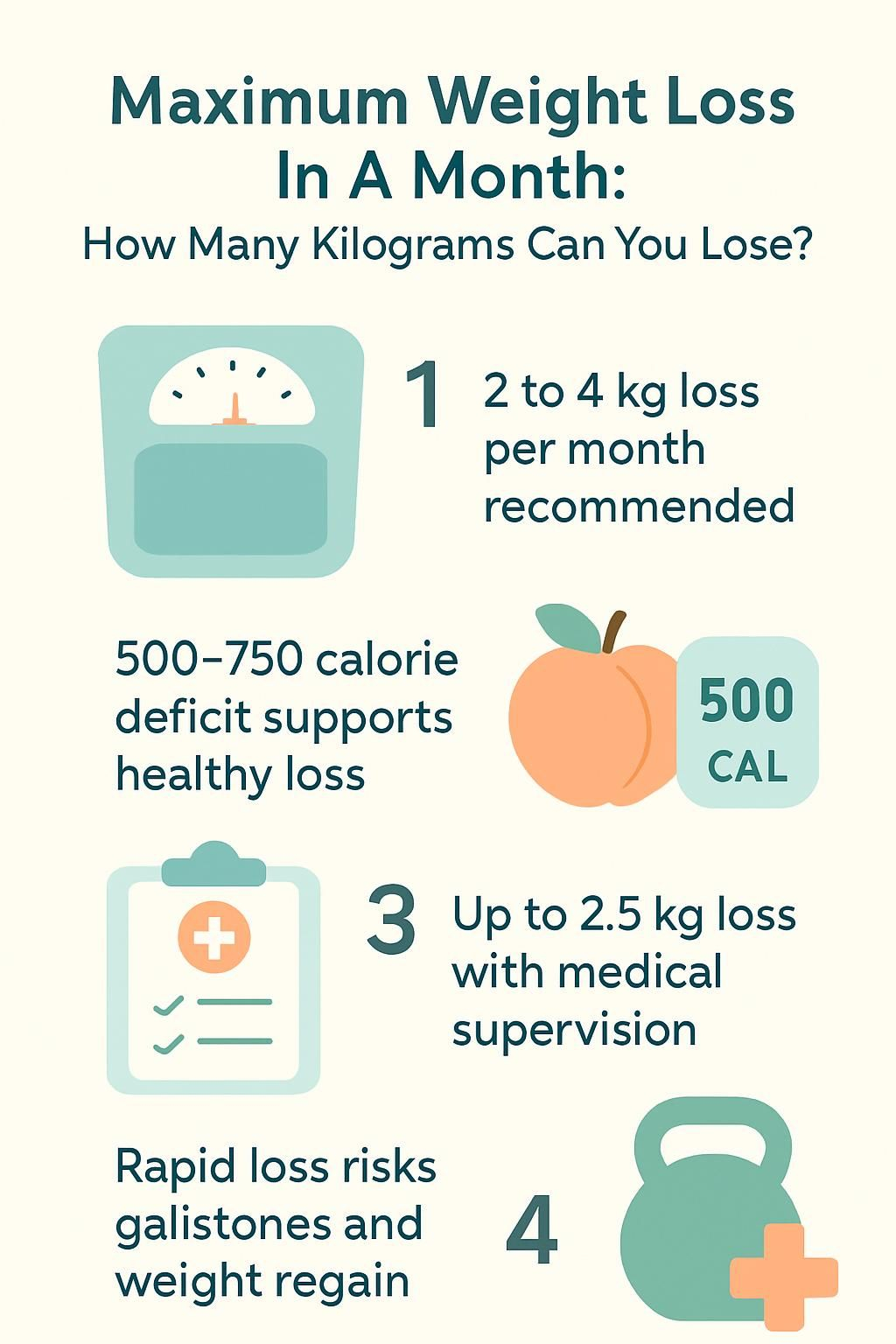Maximum Weight Loss In A Month: How Many Kilograms Can You Lose?
Our Nutrition Assistant AI Suite will transform your body. You will lose fat, get toned, and build muscle. Gain confidence and optimal health.
If you are trying to lose weight, you likely wonder how much weight you can safely lose in a month. Most adults can aim for 0.5 to 1 kilogram per week. That equals about 2 to 4 kg across four weeks, which supports healthy weight loss without high risk.
This guide explains what shapes monthly results, including your starting weight, calorie deficit, diet, and exercise. You will also see why losing weight too quickly can harm your health, and how to build habits that last. Use these tips to choose the best pace for your body and schedule.
Find out what works best for healthy weight loss ahead.
Key Takeaways
- Most people can safely lose 0.5 to 1 kg per week, or about 2 to 4 kg per month, based on Centers for Disease Control and Prevention guidance.
- Higher starting weight often brings faster early drops, but early losses include water and muscle, not only body fat.
- A daily calorie deficit of 500 to 750 calories supports steady progress. Larger deficits raise the risk of muscle loss and nutrient gaps.
- Doctor-guided options like Semaglutide may help lose up to 2.5 kg in the first month. Very-low-calorie diets require medical supervision.
- Rapid weight loss raises risks for gallstones, slower metabolism, and regain. Gradual habits and consistent exercise support long-term success.

Key Factors Influencing Weight Loss in One Month

Think of weight loss like a budget, calories in and calories out must balance. Your monthly outcome depends on your starting weight, your calorie deficit, and your choices about food and activity.
How Does Starting Weight Affect Monthly Weight Loss?
People with a higher starting weight often see bigger drops in the first month. Larger bodies burn more calories at rest, which can speed early change on the scale.
Cutting carbs or sodium can cause a quick fall in water weight during the first two weeks. Many charts show an average of 2 to 4 kg per month. If you start heavier, you might lose more at first, though not all of it is fat.
Medical programs, including weight loss medications or bariatric surgery, are used when there is a lot to lose or when health risks are high. Some studies report a 10 to 15 percent loss of total body weight across six months under medical care.
I started my weight loss journey at 120 kg, and in my first month, I lost 6 kg just through a balanced diet and walking every day.
Fast early losses can be exciting, but they can be hard to maintain. The CDC advises 0.5 to 1 kg per week for steady results. Larger weekly drops often include water and muscle along with fat.
Your monthly weight loss will reflect your current weight, your plan for diet and exercise, and whether you use medical support.
What Role Does Calorie Deficit Play in Losing Weight?
A calorie deficit means you burn more calories than you eat. Over time, that gap reduces fat. Roughly 7,000 calories equal one kilogram of body weight.
Create a daily deficit of about 500 calories to lose around 0.5 kg per week. If you can maintain a 750 calorie gap, you may reach about 1 kg per week. This range is both effective and safer for most people.
Food tracking helps many people stay consistent. Logging meals can prevent mindless eating and helps you hold a steady deficit.
Going far beyond a 750 calorie deficit can speed weight loss but raises risks. You could lose muscle, slow your metabolism, and miss key nutrients. Crash plans often lead to fast regain. A moderate, steady deficit supports better long-term results.
How Does Diet and Nutrition Impact Weight Loss?
A balanced plan that is high in protein and fiber helps you stay full. Whole grains, fruits, and vegetables promote satiety, which reduces overeating.
Protein helps protect muscle while you lose fat, especially with strength training. Common daily targets for low-calorie plans are 1,200 to 1,500 calories for many women and 1,500 to 1,800 for many men.
Very-low-calorie diets, about 800 calories per day, must be doctor supervised. Skipping food groups or following extreme rules can bring side effects like fatigue, hair loss, or constipation.
These plans often miss key nutrients. Instead, choose fiber-rich foods, lean protein, and healthy fats. That mix supports fat loss and makes it easier to keep the weight off.
How Important Is Exercise and Physical Activity for Weight Loss?
Food choices drive progress, yet activity is a strong partner. Regular exercise increases calorie burn and helps you hit 1 to 2 pounds per week or about 2 to 4 kg per month.
The CDC suggests at least 150 minutes of moderate activity weekly. Many people do well with more, such as 45 to 60 minutes on most days, especially for weight maintenance.
Combine cardio and strength work to protect muscle and keep metabolism steady. High-Intensity Interval Training, called HIIT, can burn more calories in less time. If you follow a very-low-calorie plan, intense training may need to wait until calories increase.
For me, adding brisk walks and short HIIT sessions made it easier to stick to my plan.
Exercise is the most underutilized antidepressant and it’s free.
Movement does more than burn calories. It protects strength and supports long-term weight control.
How Do Metabolism and Genetics Influence Weight Loss?
Metabolism is how many calories you burn at rest. This is your basal metabolic rate. A higher rate means your body uses more energy even while sitting.
Genetics can affect appetite, hunger hormones, and how quickly you burn fat. Some medical conditions, such as thyroid disease or PCOS, can slow the process. Certain medicines can also reduce calorie burn.
Rapid dieting often brings a drop in metabolic rate. That can lead to regain. Making steady changes helps protect your metabolism and supports maintenance over time.
What Is the Safe and Recommended Weight Loss Range?
Safe targets act like guardrails. They keep you moving forward while staying healthy.
How Much Weight Can You Lose Safely Per Week?
Most adults can safely lose 0.5 to 1 kg per week, according to national health guidance. That equals about 1 to 2 pounds every seven days.
Reaching this range usually requires a daily deficit of 500 to 750 calories. Trying to lose more than 1 kg per week can increase the chances of muscle loss, nutrient shortfalls, and a slower metabolism. Aggressive plans should be supervised by a clinician.
Weekly weigh-ins and simple tracking help you monitor progress and stay within a safe zone. Smaller, steady losses are easier to maintain and feel less draining.
What Is the Typical Weight Loss Per Month?
If you follow a healthy diet and regular exercise, you can expect about 2 to 4 kilograms in a month. This pace lines up with what health experts recommend for most people.
From my experience, consistent eating and movement kept me within this range over several four-week periods. Losing more than 4 or 5 kilograms in a month without medical care raises health risks, such as gallstones or muscle loss.
Medications like Semaglutide can bring early results, around 2.5 kg in the first month. With lifestyle change alone, many people see 6 to 12 kg across three months, depending on adherence and starting point.
Monthly results vary with metabolism, sleep, stress, body fat level, and daily routine.
Factors That Can Speed Up Weight Loss
Some methods can accelerate progress; the best plan is the one you can keep.
Does Higher Initial Body Weight Lead to Faster Loss?
Higher starting weight often means bigger first-month drops. Larger bodies have higher energy needs, which can deepen your calorie deficit.
People with obesity who undergo bariatric surgery or follow very-low-calorie diets may see rapid early changes. These approaches are reserved for specific medical needs.
Early losses often include water. As your body uses stored glycogen, which holds water in the muscles and liver, that water is released. The scale falls quickly at first, then slows.
Fast results can feel motivating. Research also shows that many people regain some weight within a year if habits do not change. Medical programs monitor these patterns and adjust plans to support maintenance.
How Does High-Intensity Interval Training (HIIT) Boost Weight Loss?
HIIT alternates short bursts of hard effort with brief rest. It can burn more calories during the workout and keep your metabolism elevated for hours after.
Many HIIT routines include bodyweight or resistance moves, which helps preserve muscle while you cut fat. If time is tight, two or three 20 minute HIIT sessions each week can boost results.
When I added short HIIT workouts to my walks, I broke through a plateau and regained momentum.
What Are Very-Low-Calorie Diets (VLCDs) and Their Effects?
VLCDs provide about 800 calories per day. Doctors may use them for adults with obesity, before surgery, or when quick results are needed for health reasons.
These plans often rely on medically formulated shakes or bars. Short term, some people lose 1.5 to 2 kg per week under supervision. Risks include nutrient deficiencies and higher odds of gallstones when used too long or without proper care.
Exercise may be reduced at first due to low energy intake. Do not attempt VLCDs without medical oversight.
When Are Medically Supervised Weight Loss Programs Used?
Clinicians use supervised programs for people with obesity or health risks such as diabetes. Options can include Semaglutide, known by brand names like Ozempic and Wegovy.
Clinical research shows about 2.5 kg lost in the first month for many users, with 10 to 15 percent of total body weight over six months or more. Supervision helps manage side effects and keeps nutrition on track.
Bariatric surgery is another medical option for severe cases. I joined a supervised plan after a high blood sugar warning, and the regular check-ins kept me consistent and safer.
What Are the Risks of Losing Weight Too Quickly?
Fast weight loss can look appealing, but it carries real downsides. Understanding the risks protects your health.
How Does Rapid Weight Loss Cause Muscle Loss?
Deep calorie cuts, especially below 1,000 per day, push your body to break down muscle and even bone along with fat. Low protein intake and no strength training make losses worse.
Research shows that extreme deficits make your body use muscle for energy. This lowers your metabolic rate and increases the chance of regain after the diet ends.
I lost more than 10 pounds in one month once, and I felt weaker. Keeping protein high and lifting weights helps protect lean tissue while losing around 0.5 kg per week.
What Nutritional Deficiencies Can Occur?
Very-low-calorie plans often miss key nutrients. Symptoms can include fatigue, hair loss, brittle nails, and frequent illness.
Deficiencies in vitamins like B12 and D, and minerals such as iron, calcium, and potassium, can develop quickly. Digestive problems like constipation or diarrhea may appear.
Medical teams can recommend supplements and lab checks to reduce risk. Supervision is especially important if the deficit is large.
Why Are Gallstones a Risk with Fast Weight Loss?
Fast weight loss increases the chance of gallstones, especially beyond 0.5 to 1 kg per week. Very-low-calorie diets and strict plans are common triggers.
Rapid fat loss causes the liver to release more cholesterol into bile. This can form stones, block bile flow, and cause severe pain with nausea or vomiting. People with obesity and those losing weight very quickly face higher risk.
Supervised plans reduce complications and help you reach goals more safely.
How Can Rapid Weight Loss Slow Down Metabolism?
Large calorie cuts can reduce thyroid and hunger hormones, which slows your metabolic rate. Your body responds to a shortage by burning fewer calories at rest.
This makes ongoing loss harder and can cause rebound once the diet ends. The longer the crash plan, the stronger the adaptation. You might stall even with the same routine.
I tried a very-low-calorie approach once, and my energy dropped while fat loss stopped. Protecting muscle with strength training and moderate deficits helps maintain a higher burn rate. Recovery from fast loss can take months.
How Can You Achieve Safe and Sustainable Weight Loss?
Sustainable weight loss comes from simple steps that you can repeat. Consistency beats intensity.
How to Create a Balanced Calorie Deficit?
Target a 500 to 750 calorie deficit per day. This range supports steady progress and lowers the chance of fatigue or hair loss. Use a food diary or app for accurate tracking.
If you feel lightheaded or unusually tired, ease up and reassess. Include fiber-rich carbs and adequate protein to stay full and protect muscle.
Small, flexible changes reduce binge risk and make the plan easier to follow. A registered dietitian can help tailor portions and troubleshoot stalls.
Why Include Strength Training in Your Routine?
After setting your calorie target, add strength training. Lifting weights or using resistance bands helps preserve muscle as the scale drops.
More muscle increases calories burned at rest, which supports a healthier metabolism. Research shows at least two strength sessions per week improves body composition and helps maintain results.
Pair strength work with cardio for the best mix. This combination promotes fat loss while protecting lean mass, which reduces the chance of a metabolic slowdown.
What Are the Benefits of Prioritizing Whole Foods?
Your food choices power your plan. Whole foods provide steady energy and essential nutrients while helping control hunger.
- Fruits and vegetables add fiber and volume for fewer calories.
- Lean proteins like poultry, fish, eggs, and beans support muscle repair.
- Whole grains, such as oats and brown rice, help you stay full longer.
- Healthy fats from nuts, seeds, and olive oil support hormones and taste.
Refined carbs, such as candy or white bread, can spike blood sugar and lead to cravings. In my logging experience, shifting from packaged snacks to whole foods reduced urges and kept my calories on track.
How Does Staying Hydrated Support Weight Loss?
Water aids digestion and fat metabolism. Drinking a glass or two before meals may reduce portions and daily intake.
Thirst often feels like hunger, which can lead to extra snacking. Staying hydrated helps prevent that mix-up and reduces constipation during calorie deficits.
Good hydration also supports workouts. Better performance helps you burn more and feel stronger.
Why Are Adequate Sleep and Stress Management Important?
Seven to eight hours of sleep helps control hunger hormones and cravings. Low sleep often leads to more snacking and less activity.
Chronic stress raises cortisol, which can increase appetite and fat storage. Mindfulness, short walks, or breathing drills can calm stress and curb emotional eating.
Quality sleep supports muscle recovery and steadier fat loss. I noticed fewer late-night snacks and better focus after improving my sleep routine.
What Challenges Might You Face During Weight Loss?
Progress is rarely a straight line. Expect obstacles and prepare simple solutions.
How to Overcome Weight Loss Plateaus?
Plateaus happen as your body adapts. Recheck calories based on your current weight and activity level.
Change your training routine. Add or increase strength work, try intervals, or raise step counts to boost burn. Increase protein and fiber to support fullness and muscle retention.
Cutting back on refined carbs often restarts progress. A dietitian can help find hidden calories or planning gaps. Stay patient, and keep habits steady.
What Are Effective Ways to Deal with Cravings?
Cravings can derail a good plan. Eating enough protein and fiber helps you feel full longer and reduces urges.
Keep meals regular to stabilize hunger hormones like ghrelin. Drink water first when a craving hits, then wait a few minutes to reassess.
Choose smart snacks such as nuts, Greek yogurt, or fruit. Use mindful eating, which means pausing and checking your hunger level before you eat. Tracking triggers like stress or boredom helps you spot patterns.
Studies show that people who use mindful eating techniques experience a 31 percent reduction in binge episodes over three months1. You may find this approach helpful if you often eat while distracted or stressed.
Many individuals report greater control over their choices after keeping a craving diary for just two weeks2.
1: Kristeller JL et al., Appetite, 2014
2: Forman EM et al., Journal of Consulting and Clinical Psychology, 2007
How Can You Maintain Motivation Throughout Your Journey?
Clear goals keep you focused. Set targets like 0.5 to 1 kilogram per week and track progress in an app or journal.
Lean on friends or a group for accountability. Use progress photos or a favorite pair of jeans to see changes that the scale may miss.
Reward milestones with non-food treats, such as new gear or a day trip. Pay attention to health wins like better sleep, higher energy, and improved lab results. Professional support can help if motivation dips.
What Tools Help Track and Monitor Weight Loss Progress?
Good tools make progress visible; small wins build momentum.
Which Calorie-Tracking Apps Are Most Useful?
MyFitnessPal makes logging fast with a large food database and barcode scanning. It estimates daily calories, tracks your deficit, and shows trends in simple charts.
Lose It! is also easy to use and adjusts goals based on your targets. Both apps can sync with wearables for a full picture of eating and activity. Sharing your data with a coach or clinician can improve support.
How Can Fitness Wearables Assist in Weight Loss?
Wearables track steps, workouts, calories burned, and even sleep. Real-time feedback helps you move more on low-activity days.
Many devices sync with popular apps. Goal alerts and streaks can boost consistency and help you reach your monthly weight loss goals. My tracker showed me how sedentary long workdays were, so I added short walks after meetings.
Regular weigh-ins and measurements confirm if your daily actions are working.
Why Are Regular Weigh-Ins and Measurements Important?
Weekly weigh-ins show trend lines and help catch regain early. After reaching your goal, move to biweekly or monthly checks to stay in maintenance.
Measure your waist, hips, and thighs. Photos help when the scale stalls. I once saw no scale change for three weeks, but my waist kept shrinking, which kept me motivated.
These habits help you stay honest and focused.
Special Cases and Exceptions in Weight Loss
Some situations call for different strategies. Health conditions and treatments can change the pace and plan.
What to Expect After Bariatric Surgery for Weight Loss?
Weight usually falls quickly in the first months after bariatric surgery. Many people lose 10 to 15 percent of starting weight across six or more months with close follow-up.
Regular visits with a clinician and a nutrition expert are required to protect nutrients and muscle. Skipping lifestyle changes, like healthier eating and activity, raises the chance of regain.
A friend with gastric bypass lost kilograms quickly but needed weekly support in the first three months. Even after surgery, walking and strength work help keep results.
How Does Intermittent Fasting Affect Weight Loss?
Time-restricted eating, such as the 16:8 method, limits meals to an eight hour window. Early results can be quick, especially with a calorie deficit.
The 5:2 approach creates lower calorie days during the week. Fasting is not ideal for everyone, especially with certain medical conditions or medications. Many studies find that long-term results are similar to standard calorie control.
I tried time-restricted eating for a month and saw fast changes, but steady daily habits felt easier to maintain.
How to Manage Weight Loss with Medical Conditions?
Conditions like PCOS or thyroid disease can slow results and change appetite. Some medicines, such as steroids or antidepressants, can increase hunger or affect calorie burn.
Talk with your healthcare provider before major changes. Plans often need adjustments to fit your condition and medications. Rapid diets may be unsafe for some health issues, so close monitoring is important.
Progress may be slower, which is normal. Consistency matters more than speed.
Why Is Long-Term Weight Management Important?
Losing weight is one step. Keeping it off takes practice and simple systems.
How Can You Prevent Weight Regain?
Choose meals built around protein and fiber to stay full and reduce cravings. Limit refined carbs, which can spike hunger.
Track portions and intake so trends do not sneak up. Aim for 150 to 360 minutes of weekly activity, including walking, cycling, or group classes.
Sleep about eight hours, which supports hunger control and recovery. Weigh weekly or monthly to spot early regain. Support from friends, a coach, or a community helps you stay engaged.
Small, steady habits beat extreme plans for long-term success.
What Are Key Healthy Habits for Lifelong Weight Control?
Focus on nutrient-dense foods such as vegetables, fruit, lean proteins, and whole grains. These choices keep calories balanced while keeping you full.
Move regularly with both cardio and strength work at least three days per week. Muscle supports metabolism and daily function.
Drink enough water, manage stress with simple tools like short walks or deep breathing, and sleep seven hours or more. Use trackers to review progress and adjust early.
I adopted these habits after gaining 10 kilograms in college. Keeping them simple made maintenance easier than any short-term diet. A registered dietitian helped me fine-tune meals when challenges came up.
Conclusion
For most adults, safe weight loss in a month is about 2 to 4 kg. Your results depend on starting weight, calorie deficit, diet quality, exercise, sleep, and genetics. Rapid weight loss often includes water and muscle, not just fat.
Aim for balanced habits and gradual progress. Protect your metabolism with adequate protein and strength training. Talk with a healthcare professional before major changes or if you plan a very-low-calorie diet.
Healthy routines, steady movement, and simple tracking help you stay on course. These steps support sustainable weight loss in a month and make maintenance more likely over time.
FAQs
1. How many kilograms can a person lose in one month safely?
Most health experts agree that a safe rate of weight loss is about 0.5 to 1 kilogram per week. This means you can expect to lose about 2 to 4 kilograms in a month if you follow a healthy eating plan and exercise regularly. Remember that weight loss rates can vary based on age, gender, and starting weight.
2. What factors affect maximum weight loss in a month?
Several factors influence how much weight you can lose in a month. These include your starting weight, metabolism, physical activity, and the type of diet you follow. Remember that weight loss is not the same for everyone. Genetics and medical conditions can also play a role.
3. Is rapid weight loss in a month safe for most people?
Losing weight too quickly can lead to muscle loss, nutritional gaps, and other health problems. Most doctors recommend slow and steady weight loss for lasting results. Remember that weight loss should focus on fat loss, not just losing water or muscle.
4. What is the best way to achieve maximum weight loss in a month?
A balanced diet, regular exercise, and enough sleep help support healthy weight loss. Tracking your food and activity can keep you on track. Remember that weight loss is more likely to last when you make small, steady changes instead of trying extreme diets.
Summary: Safe weight loss is about 2 to 4 kilograms per month for most people. Many factors affect results, and slow progress is usually healthier. Remember that weight loss should be safe and based on healthy habits for lasting change.







